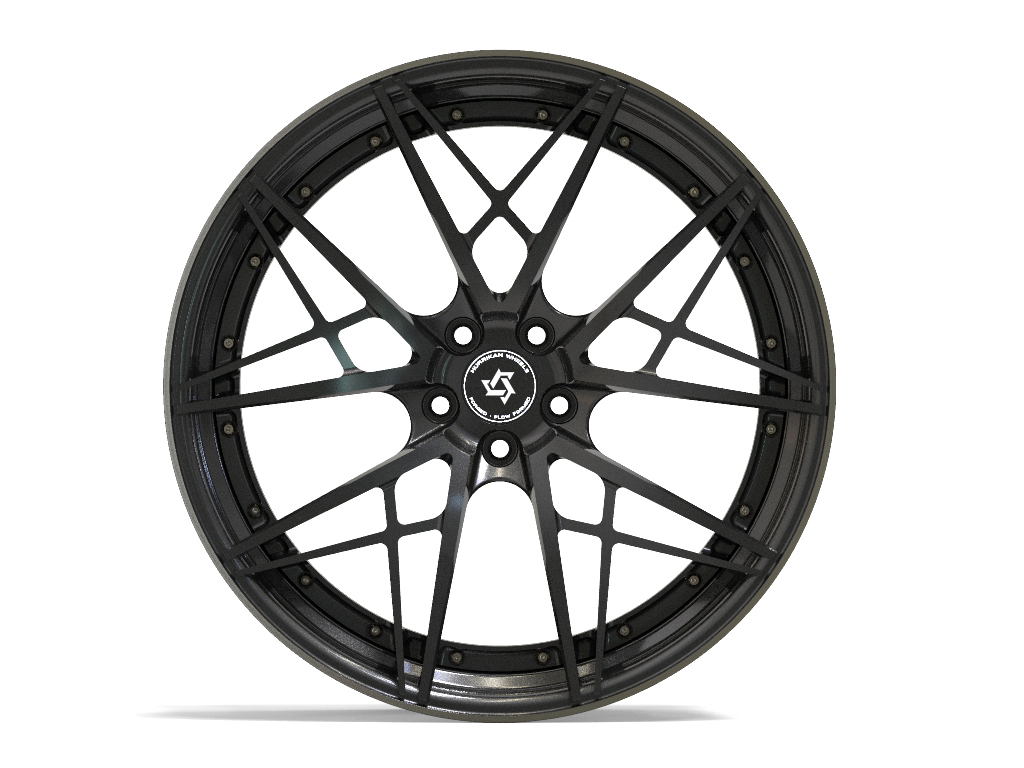jwheel is here to talk to you about how to change the wheels to look good and be safe.
To get started with wheel modification, these 3 big pieces of data must be clarified
In fact, any modification work needs data support. It's the same as having your clothes made to order, if you don't have the right size, you're going to look a bit out of place. So if you want to modify the wheels you like, you first have to make sure they fit: the wheel data has to match the original car!
Is changing the wheels handsome the end of the story? If you don't know these things, it's a waste of time to buy the most expensive wheels
If you don't change your car, it's better to go to the sea with a cart" is basically what all car modification players would say.
The first thing you need to do is to change your wheels. The first thing you do is change your wheels.
A good set of wheels can indeed change the whole "look" of a car and even its performance. But that said, many of you may ask: what are the right wheels for you?
What are the right wheels for your car?
What are the "minefields" of wheel modification?
jwheel is here to talk to you about how to change the wheels to look good and be safe.
To get started with wheel modification, these 3 big pieces of data must be clarified
In fact, any modification work needs data support. It's the same as having your clothes made to order, if you don't have the right size, you're going to look a bit out of place. So if you want to modify the wheels you like, you first have to make sure they fit: the wheel data has to match the original car!
So, what are the basic wheel data?
The first is whether the new wheel will exceed your wing's 2 figures: ET value and J value
The ET value is the Off-set value, i.e. the offset (commonly known as the bias value) in MM, and there are three types: positive, zero and negative. In layman's terms: the larger the ET value, the closer the wheel is to the inside, the more inset it is; conversely, the smaller the ET value, the more outward the wheel is.
The J value determines how thick and wide the wheel is
Next is a common value for the width of our wheels, the J-value.
This figure is generally based on the width of our rim section and represents the width of the wheel, while the J value represents the shape and height of the wheel flange. 1J = 25.4mm
Well, after recording these two data we can basically be sure that when we change the wheel we can know whether the modified wheel is suitable for our car, so that the wheel does not protrude out like a buck tooth after the car.
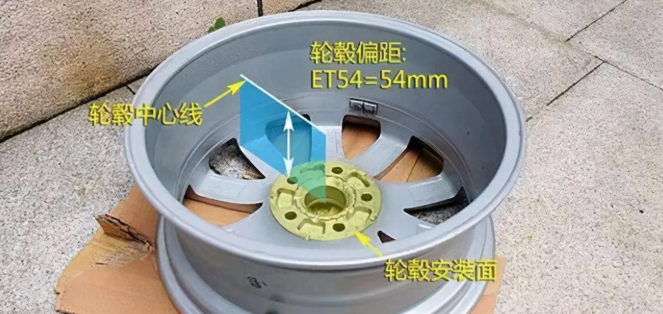
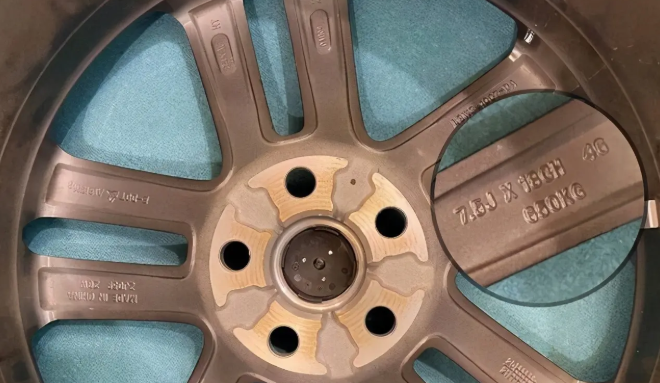
The above diagram shows that the original wheel is 18 inches, 7.5J, ET46, the original front wheel is 37mm from the outer edge of the wing and the rear wheel is 45mm from the wing.
If the front and rear wheels need to be flush, without changing the tyre width, the ET value should be reduced to ET10 for the front wheels and ET0 for the rear wheels
If the front wheels are 235/40 R19 and the rear wheels 265/35 R19, then the wheel data should be changed to 235/40 R19 for the front and 265/35 R19 for the rear.
The wheel data should be changed to 19" 8J ET35 for the front wheel and 19" 9.5J ET30 for the rear wheel (leaving 5mm for the tyre flange).
Now that we have the flush wheel data, the next step is to consider whether the wheel will fit on the car!
Here we need to look at 2 major pieces of data: wheel PCD hole distance and wheel centre hole distance
Firstly, the PCD hole distance determines whether the wheel will fit on the car.
The PCD hole pitch determines the diameter of the bolt holes in the wheel, often called the "rim hole pitch" and is usually expressed as 4*100 (example: Fit, Rainbird), 5*120 (example: most BMW models) etc. 4/5 means there are 4 or 5 bolt holes, 100/120 means the bolt holes have a circular diameter of 100mm or 120mm. 120mm.
(Wheels with improperly spaced holes can be fixed with flanges or reducers, but this is a safety hazard)
Then it is a question of whether the hub will catch on the half-shaft head, depending on the centre bore distance.
The centre hole is also called the middle circle of the wheel, which refers to the circle above the half-shaft head when the wheel is mounted. This is why most wheel modifications are made with a large centre hole (over 65mm) to suit different car types.
(The size of the centre bore will also affect the installation of the vehicle, generally speaking the bore spacing is only bigger, not smaller, and it is best to make it the same)
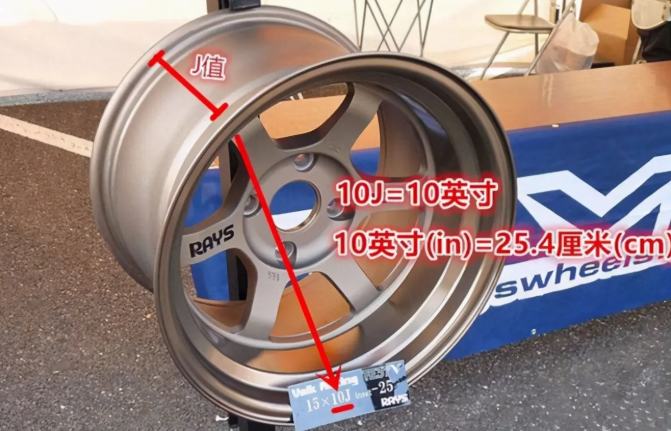
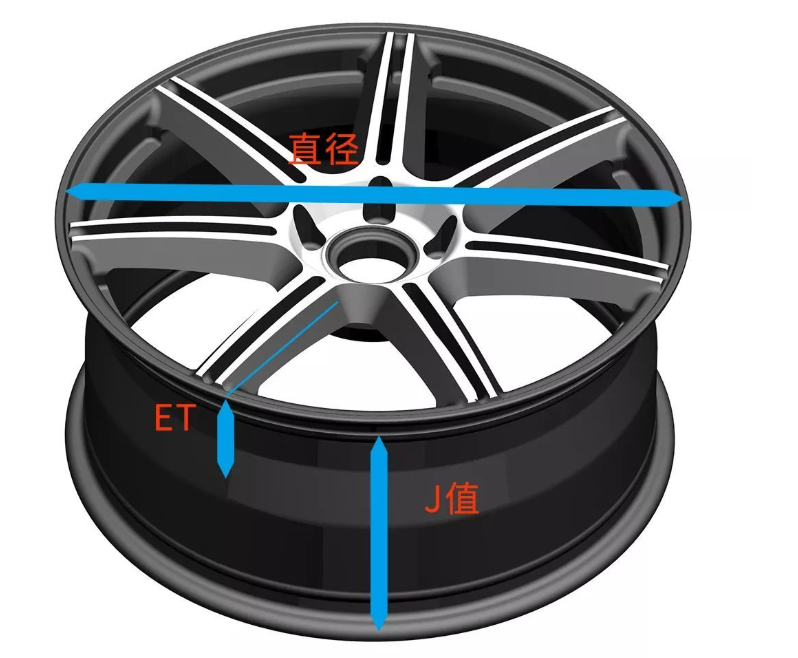
There are also dark pits in wheel selection
False J-values" and "throw-away edges" in tuning products
For many modifiers, modifying wheels is all about looking good, but why are the wheels you buy always thick and ugly? In fact, there is something very confusing here, called "false J-value"!
This is a problem that perhaps even the wheel sellers don't have in mind. Let's use a very simple and straightforward method to look at the edges of the wheel. First of all, let's take a look at a fake J-value wheel. If there is a thick, aesthetically pleasing looking rim, it is a fake J-value, and the actual J-value is less than its calibration, generally by 0.5 (for example: 7J calibration, the actual J-value is only 6-5), which requires the owner to measure the width of the wheel section when buying the wheel himself.
Fake J-value modified wheels (see the nice rim)
Then we come to the real J-value wheel, which actually does not have that nice wrap around rim and is relatively smooth at the edges. So in terms of aesthetics, it's a little less interesting than the fake J wheels.
True J-value modified wheel (no visible rim)
Big rimmed wheels, good looks don't work
With all the beautiful cars out there, why don't all the original wheels have a rim?
When it comes to this, many people have the question in their mind: are rimmed wheels necessarily unsafe?
Well, let's ask the car manufacturers of the major brands why they don't use them. Lack of money? Or is it a lack of aesthetics? What is the purpose of large rimmed wheels, bling...bling is very eye-catching and makes you the brightest star on the road ...... It's simple: to give you a good look and ask you to pay for it.
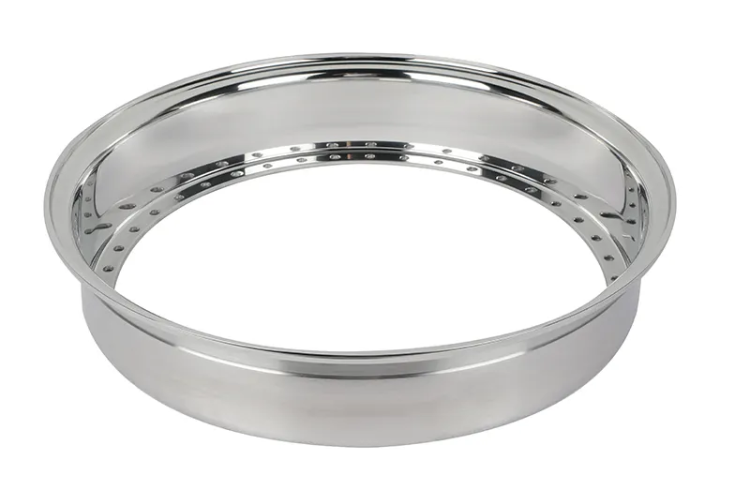
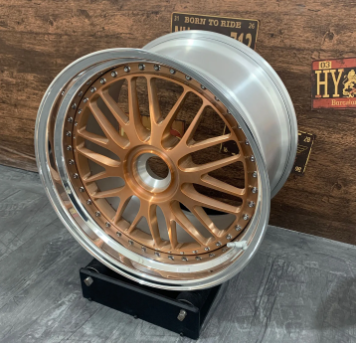
The large rimmed wheels are beautiful, but when you encounter potholes or need to drive at the limit (on a race track, etc.), the skirt-like projection is closer to the hard ground and lacks the cushioning protection of the tyres, which means that the probability of "hard contact" with the ground is greatly increased, which can easily lead to The lack of cushioning on the tyres means that they are more likely to come into contact with the ground, which can lead to deformation.
On the other hand, the original car is a true J with no rim rubbing, for strength and safety. Let's take a look at the wheels on the Lamborghini Huracan, with a flat ratio of 30 and a width of 305.
Big rimmed wheels: not a good look, not a good use, show off the pomp and circumstance, suitable for the posture route
However, the strength and design of the true J-value wheels without the rim are designed with durability in mind, so they are significantly stronger than the rim in dealing with extreme conditions. Wheels: Would you run a marathon wearing the fashions pictured below?
How to change your tyres after choosing your wheels
Remember the 3% rule and you can switch at will
Next comes the delightful part of choosing tyres. Since we are changing the wheels, we naturally have to change the original tyres together, so the question arises how to choose the tyres?
The J-value matches the width of the tyre and the flat ratio follows the 3% principle
As we all know, wider wheels naturally mean wider tyres (except for the turtle conversion), the width of the wheel determines the width of the tyre, and to get wider tyres, the wheel must first be a certain width. There are also standards for the width of wheels that can be fitted to different J values.
The following chart will basically solve the needs of the vast majority of our friends.
We can use this table to find out the width of the tyres that can be fitted for each J value
As you can see from the table, each J value has a recommended tyre width. For example, for a 7J wheel, the standard tyre width is 215, but of course it is possible to fit a smaller 205, or a larger 225 width tyre, but neither is standard. With a larger width tyre, the visual impression is that the tyre is outside the wheel; with a smaller width tyre, the wheel looks more prominent.
Once you've chosen the width, it's time to consider the tyre's aspect ratio!
A tyre's aspect ratio is a figure that refers to the height of a tyre's cross-section as a percentage of its maximum cross-section width. For example, a 195/55 R15 tyre has a maximum cross-sectional width of 195 mm, a 55% aspect ratio and a 15-inch inside diameter.
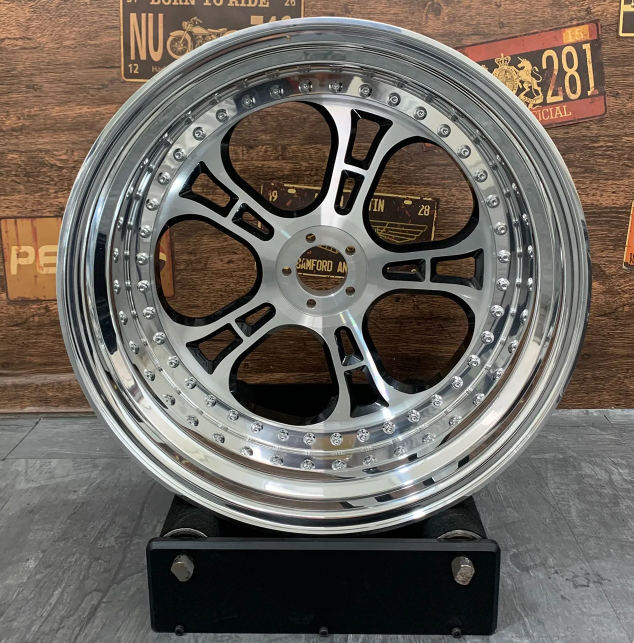
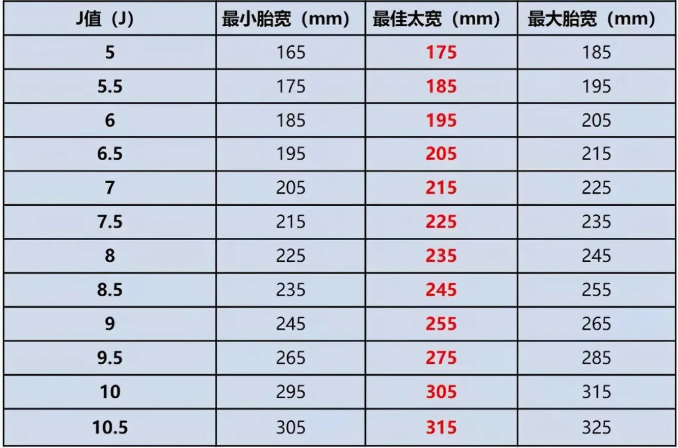
For example, every 10mm increase in the tyre width requires a 5% reduction in the aspect ratio, as does every 1 inch increase in the wheel. For rear-wheel drive models, due to the problem of inconsistent front and rear wheel widths, it is best to calculate the front and rear wheel circumferences yourself to avoid the problem of smaller fronts and larger rears.
If you don't want to do the calculations yourself, there is an easy tool for you. You can find a wheel calculator in your car playing home, where you can convert the original wheel and tyre specifications on your own.
Finally, let's talk about the impact of flat ratios on driving. Tyres with high flat ratios are relatively comfortable due to their long walls and strong cushioning ability, but they have a poor road feel and will feel like they are pushing the head when cornering with weak lateral support.
Conversely, low-flat ratio tyres, with their shorter walls and relatively wider tread, can withstand more pressure due to their large grounding area, and are more responsive to the road, offering strong lateral resistance when cornering and excellent handling.
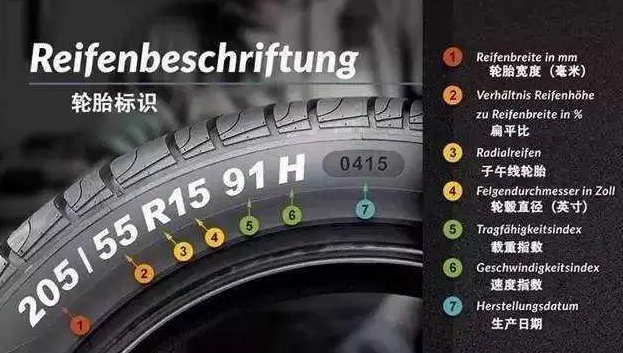
Jwheel, as an professional wheel manufacturer, concentrates in R&D and manufacturing of aluminum alloy wheels, including casting wheels, forging wheels and flow-form wheels. The products of it have passed the certifications of SEI、SEMA,VIA, JWL, JWL-T, TUV and so on. Since establishment, Jwheel has been developing steadily, with rich experience of designing and producing aluminum alloy wheels. It has earned the appreciation of both domestic market and foreign market with its high technology, good quality and customer service. It provided OEM service to many international brands like Vossen, OE Wheel, TSW, Rays, ProLine, Oxygen, AUTEC, etc., and it also provide ODM service, that is, for producing a new wheel, you can just provide a sketch, drawing or picture, and then Jwheel will finish the rest parts. By the way, the MOQ of forging wheels is four. (For more information, just go to the website: https://www.jjjwheel.com)
